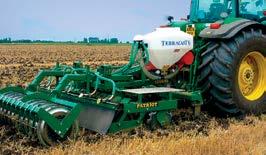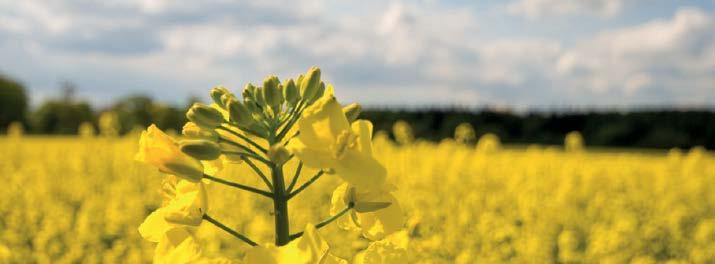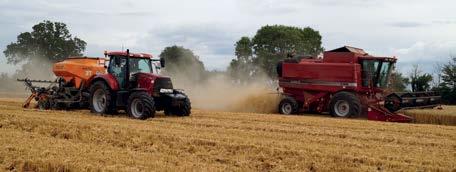
11 minute read
Glyphosate Substitution
Written by Thomas Preuße, Chief Editor “DLG-Mitteilungen” and DLG-Agrifuture Magazine Forgoing glyphosate will increase the demands made on the cultivation system as a whole. It is vital to minimise the pressure caused by weeds overall. Replacing glyphosate with one single alternative measure is therefore barely conceivable, especially in systems that do not involve the use of ploughs. Wherever ploughing is not possible or desirable, greater importance will also (have to) be given to crop rotation and/or intercrops because of this.
Are Iron and Electricity the Answer
Advertisement
If the curtain really does come down on using glyphosate at the end of 2023 in the EU we do not yet know if the UK will follow. However, it does not mean either the end of the world or necessarily a forced return to ploughing. But it will certainly make life more difficult for regenerative farmers. They will have to think more extensively in terms of 'the system' than 'the measure'. In the future, arable farming will not be led by the technology; instead, the technology will follow the arable farming objective.
For a while, the situation surrounding the most controversial crop protection active substance of all time had settled down a little, but the date has been set. Glyphosate is only approved throughout the EU until the end of 2022, and that is next year. Even if the active substance were to be registered again at EU level and approved nationally, its use will either be restricted in terms of quantity and/or will only be possible in special cases: the product has long since had its heyday. At times, it accounted for 70% of the crop protection agent volumes used in Germany. Another reason why glyphosate is so popular is that it can also be used to control volunteers such as grass weeds and rapeseed and not just rhizomatous weeds.
Farmers may say 'If I can't use glyphosate,
I'll just have to start ploughing again.' And many of them will do exactly that or are already doing so today. After all of their positive experiences, others don't want to see a plough on their land again at any price. Amongst others, Detlev Dölger and Wiebke Lenge of Hanse Agro, a private consulting company headquartered in Schleswig-Holstein, believe that both groups should rethink their stances. The standard for the technology must be the arable farming objective – and only this, not the existing technology. To determine this objective and therefore make the right decision, it is necessary to ask oneself several questions, whereby the question concerning grass weeds is at the very bottom of the list. • What are the demands of the subsequent crop; what time remains until sowing? • Does the soil have to be loosened? • What about the volume of straw and chop quality? • How deep down is the germination moisture? Where is it (too) dry or (too) moist? • What must/can I do to control rhizomatous weeds, grasses, slugs, mice or cutworms?
Winter rapeseed after winter cereal, for instance, is a classic case in which forgoing glyphosate may pose a
problem. The time between harvesting and sowing is very short, and it is very tempting to use a plough before sowing. It couldn't be easier: the straw is ploughed under, grass weeds are buried and the soil is sufficiently loosened. No wonder that plough sales have picked up again, although some people had already consigned this implement to the 'scrap heap of history'. Boundary ploughing to control the influx of grasses is a widespread standard. But is it really necessary? If the location is dry, the straw can be easily worked in and sufficient time is available, there is nothing to suggest that tillage and cultivation cannot be undertaken without the use of a plough. Here, Hanse Agro recommends shallow cultivating (4 – 6 cm and 6 – 8 cm) twice to distribute and mix in the straw, then deep cultivating once and
perhaps shallow cultivating once more as ‘false seedbed’ just before sowing. If grasses and volunteer rapeseed are involved, however, the objective is to leave their seeds as close to the surface as possible, encourage them to emerge and then control them mechanically. This is when very shallow tillage to a depth of 2 cm comes into play. Implements for this have been increasingly launched onto the market in recent years. A special share may possibly be required for loosening. Hanse Agro is going one step further in trials for problematic locations: precision sowing of rapeseed in wide rows enables subsequent hoeing to control grass weeds and/or volunteer rapeseed.
If sowing winter wheat after winter rapeseed is involved, compact disc harrows are often the solution and
problem at the same time. Working in too early and too deeply prevents the volunteer rapeseed from emerging. Again, the consultants recommend flat tillage several times using harrows, rollers or even mulchers in this case. The latter solution is expensive but very good for arable farming purposes because it encourages the rapeseed to germinate without it being buried.
In dry locations, the yield is often determined by forgoing ploughing due
to water conservation. Trials conducted by the Federal State Institute for Agriculture and Horticulture in Bernburg (LLG) of Saxony-Anhalt confirm this in a sugar beet - spring barley - winter wheat - winter barley crop rotation. Real conflicts of interest occur here: glyphosate was not required with ploughing or deep mulch seeding but led to poorer cost effectiveness (higher effort and/or lower yield). Shallow mulch seeding, strip tillage and direct sowing were not possible at this location in Saxony-Anhalt without this active substance, especially with high pressure from volunteer plants in tight crop rotations. Extending the crop rotation (in this case with lucerne) along with consistent harrowing and mulching subsequently kept the pressure caused by weeds to a manageable level in this trial. Together with glyphosate, however, we may also have to bid farewell to pure direct sowing forever. The conclusion drawn by Dr Joachim Bischoff (LLG) is that action recommendations as a patent solution are impossible. Instead, weed control should be regarded far more as a holistic system of diverse arable farming and crop production measures adapted to the specific location. Before row crops. A second 'domain' of glyphosate is its application prior to maize or sugar beet sown using mulch seeding in the spring. The 'opponents' are old weeds as well as catch crops that have not or not sufficiently been killed off during the winter. The objective is to achieve the best possible catch crop stock in order to suppress weeds. Of course, this is very difficult to establish in dry years such as 2018. The catch crop can be mechanically removed prior to vegetation. However, the prerequisite is that the soil can be driven on.
A spring-toothed harrow with uniformly shallow-cutting double-disc coulters particularly stood out in trials conducted at Bingen University of Applied Sciences with sugar beet. While the disc harrow enabled the intercrop to be regulated well, it was unable to control weeds and grass weeds. Pelargonic acid is occasionally claimed to be a substitute for glyphosate, but it proved ineffective in these trials. Straw mulch seeding is only considered to have a slight likelihood of success.
Glyphosate is not needed for maize mulch seeding, as shown by trials in southern and eastern Germany and reported on by Klaus Gehring of the Bavarian State Research Center for Agriculture. Weed control using selective herbicides functioned equally well, unlike direct sowing or strip-till systems which are reliant on pre-treatment. Electrophysical method. Compared to glyphosate, the use of electricity as a herbicide substitute appears to be a niche solution, but without the total herbicide, even implements such as the 'Elektroherb' are attracting attention. A generator driven by the PTO produces electricity that reaches the plants, where it is distributed, via skids in the tractor's front-mounted implement. In trials conducted so far, it has proved effective in controlling stubborn rhizomatous weeds and also in killing intercrops. Apparently, organisms in the soil are barely harmed. A further developed version of this system wets the plants with an electrolyte solution before the electricity is applied. This enables the necessary voltage to be significantly reduced and increases the system's comparatively low efficiency.
Conclusion: don't just deal with the symptoms. As has already been mentioned, forgoing glyphosate will increase the demands made on the cultivation system as a whole. It is vital to minimise the pressure caused by weeds overall. Replacing glyphosate with one single alternative measure is therefore barely conceivable, especially in systems that do not involve the use of ploughs. Wherever ploughing is not possible or desirable, greater importance will also (have to) be given to crop rotation and/ or intercrops because of this.
TERRACAST V2 - Establishing maximum profit


Reduced establishment cost Better pest resistance Better early establishment Improved yield Simple calibration
01353 862 044 info@techneat.co.uk www.techneatengineering.co.uk
DRILL MANUFACTURERS
IN FOCUS...

LET’S TALK OILSEED RAPE.
Mzuri Trial Farm Manager and Knowledge Exchange Officer, Ben Knight talks about how Oilseed Rape still offers growers excellent opportunities.
“Once the much-loved favourite of the British grower, the humble Oilseed Rape crop has fallen out of favour in recent years for its inconsistent establishment and relentless pressure from pests. However despite this, the crop should not be discounted as it is still one of the best break crops in our tool kit and with the right system behind it there is no reason why it cannot continue to deliver profitable returns.”
“Like all crop’s establishment is key, but for OSR good establishment is particularly important for achieving (and maintaining) a healthy crop through to harvest. The single biggest factor is to get plants up and away as quickly and as evenly as possible. Struggling crops are an easy target for pests, who can quickly take hold and decimate a crop during the vulnerable early stages.”
“On our own trial farm and from feedback from other growers, we find that the Mzuri strip tillage system suits oilseed rape and can offer a consistent and reliable method of establishment that promotes early vigour.”
“The Pro-Til consistently produces the ideal nursery seedbed for quick germination by creating tilth and placing fertiliser with the leading leg, removing air pockets with the central reconsolidation wheels and seeding at an accurate depth across the width of the drill. This combination proves ideal for oilseed rape and by giving the crop the best start, it promotes quick even, establishment across the field.”
“To make the most of the system and to preserve soil moisture reserves, we encourage our customers to leave as much of the previous crop residue on the fields surface as possible. For us at Springfield Farm this involves chopping wheat straw behind the combine and drilling directly into the mulch between the stubble rows.”
“The young oilseed rape plants thrive in this environment and the standing straw between the rows discourages pigeon activity. Often visitors to our farm are surprised by the volume of straw that we plant our oilseed rape into, but it does not hamper the crop and instead provides nutrients and increases organic matter whilst protecting soils over winter.”
“Not only does strong early growth mitigate against pigeon damage, but it also gives the crop the best chance against flea beetle. Excellent establishment combined with a variety renowned for its early vigour can bolster the crops ability to grow through the vulnerable early stages and maintain a good plant stand.”
“Oilseed rape can also be a good economic choice, delivering sound returns as well as providing valuable variety in the rotation. Since switching to strip tillage on our trial farm, our oilseed rape is consistently yielding over 4.5t/ha if not closer to 5t/ha - which is a much healthier sight than struggling to bring in 3!”
“This ability to get the crop drilled into moisture with an abundance of surface residue and have it up and away in no time was the turning point for our oilseed rape. It can be a rewarding crop if given the right conditions and I can honestly say that it has been one of our best crops since we took the plunge to stop over cultivating and underperforming. And don’t our fields of gold agree!”

Oilseed Rape on our trial farm is drilled between rows of stubble for best results and provides protection to the soil over winter. The staggered design of the Pro-Til gives it excellent clearance for easy drilling into straw and cover crop residues.


Drilled in rows spaced 66cm apart we ensure good light interception throughout the crop right through to harvest. By promoting even germination across the whole field we can achieve even crops throughout the season.











